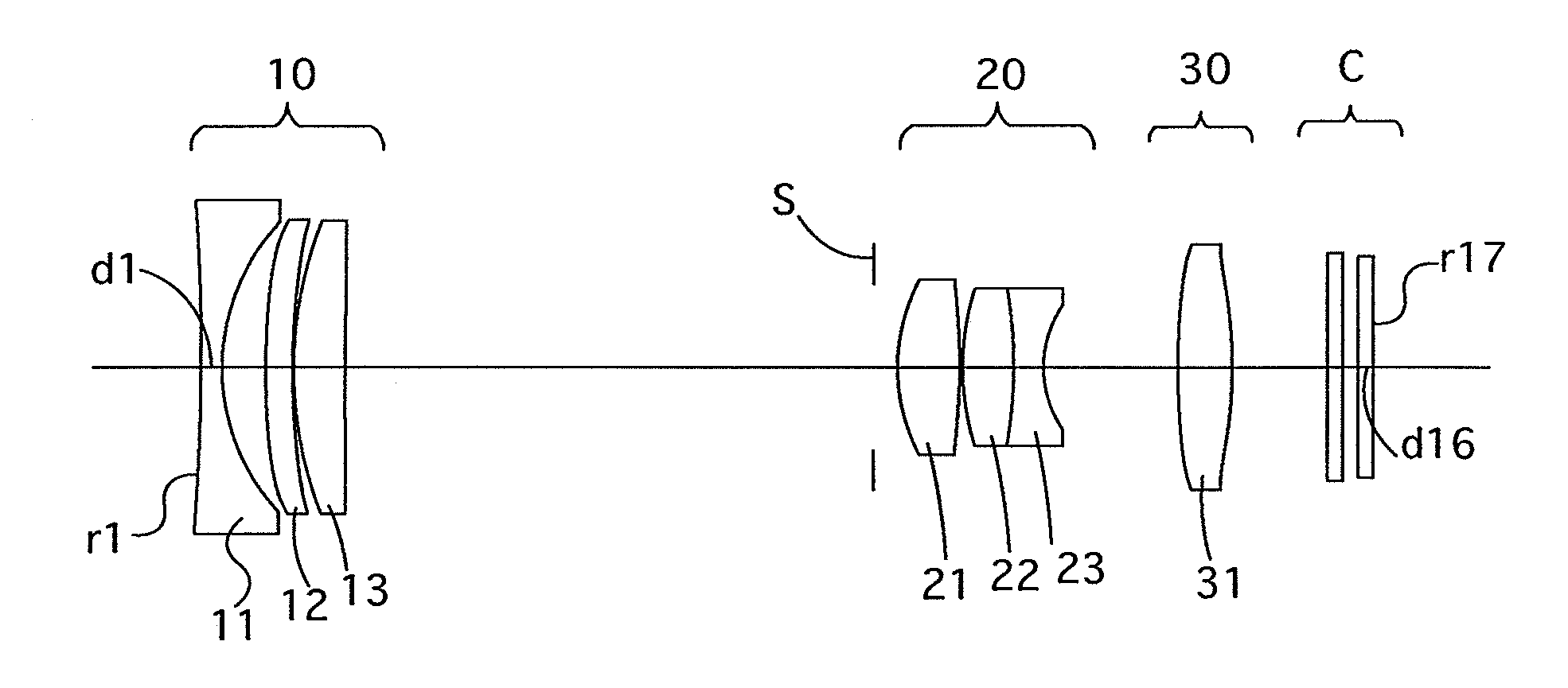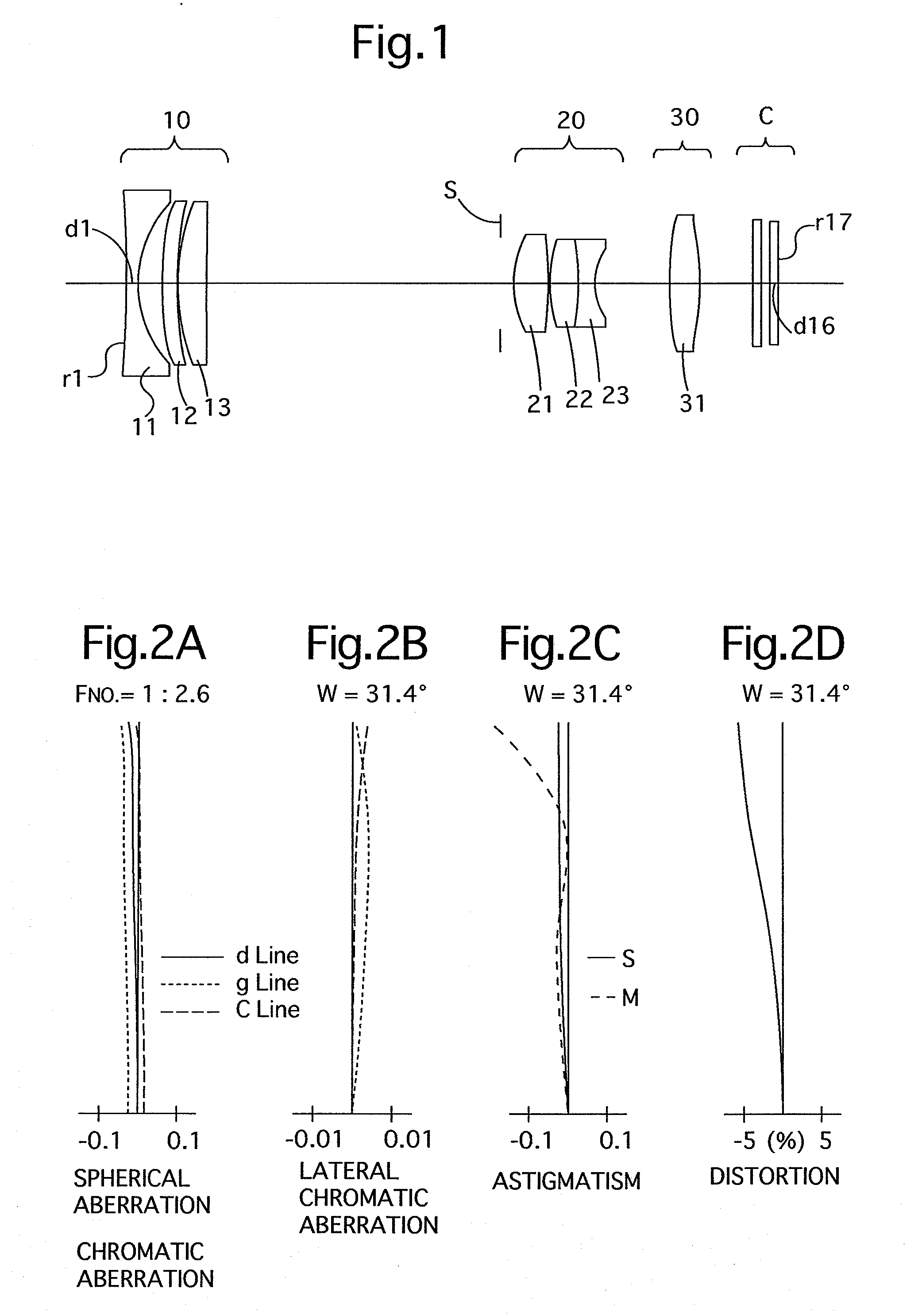Zoom lens system
a zoom lens and lens system technology, applied in the field of lenses, can solve the problems of large diameter of the first lens group, long overall length of the zoom lens system, and inability to retra
- Summary
- Abstract
- Description
- Claims
- Application Information
AI Technical Summary
Benefits of technology
Problems solved by technology
Method used
Image
Examples
embodiment 1
[0140]FIG. 1 shows the lens arrangement of the first embodiment of a zoom lens system according to the present invention. FIGS. 2A through 2D show aberrations occurred in the lens arrangement shown in FIG. 1, when an object at infinity is in an in-focus state at the short focal length extremity. FIGS. 3A through 3D show aberrations occurred in the lens arrangement shown in FIG. 1, when an object at infinity is in an in-focus state at an intermediate focal length. FIGS. 4A through 4D show aberrations occurred in the lens arrangement shown in FIG. 1, when an object at infinity is in an in-focus state at the long focal length extremity.
[0141]Table 1 shows the numerical data of the first embodiment.
[0142]The negative first lens group 10 (surface Nos. 1 through 6) includes a biconcave negative lens element (first lens element) 11, a negative meniscus lens element (second lens element) 12 having the convex surface facing toward the object, and a positive meniscus lens element (third lens ...
embodiment 2
[0147]FIG. 5 shows the lens arrangement of the second embodiment of a zoom lens system according to the present invention. FIGS. 6A through 6D show aberrations occurred in the lens arrangement shown in FIG. 5, when an object at infinity is in an in-focus state at the short focal length extremity. FIGS. 7A through 7D show aberrations occurred in the lens arrangement shown in FIG. 5, when an object at infinity is in an in-focus state at an intermediate focal length. FIGS. 8A through 8D show aberrations occurred in the lens arrangement shown in FIG. 5, when an object at infinity is in an in-focus state at the long focal length extremity.
[0148]Table 2 shows the numerical data of the second embodiment.
[0149]The basic lens arrangement of the second embodiment is the same as that of the first embodiment except that the second lens element 12 of the negative first lens group 10 is a meniscus lens element which has the convex surface facing toward the object, has a weak positive refractive p...
embodiment 3
[0151]FIG. 9 shows the lens arrangement of the third embodiment of a zoom lens system according to the present invention. FIGS. 10A through 10D show aberrations occurred in the lens arrangement shown in FIG. 9, when an object at infinity is in an in-focus state at the short focal length extremity. FIGS. 11A through 11D show aberrations occurred in the lens arrangement shown in FIG. 9, when an object at infinity is in an in-focus state at an intermediate focal length. FIGS. 12A through 12D show aberrations occurred in the lens arrangement shown in FIG. 9, when an object at infinity is in an in-focus state at the long focal length extremity.
[0152]Table 3 shows the numerical data of the third embodiment.
[0153]The basic lens arrangement of the third embodiment is the same as that of the first embodiment except the fifth lens element 22 and the sixth lens element 23 which constitute the cemented lens of the positive second lens group 20. More specifically, the fifth lens element 22 is a ...
PUM
 Login to View More
Login to View More Abstract
Description
Claims
Application Information
 Login to View More
Login to View More - R&D
- Intellectual Property
- Life Sciences
- Materials
- Tech Scout
- Unparalleled Data Quality
- Higher Quality Content
- 60% Fewer Hallucinations
Browse by: Latest US Patents, China's latest patents, Technical Efficacy Thesaurus, Application Domain, Technology Topic, Popular Technical Reports.
© 2025 PatSnap. All rights reserved.Legal|Privacy policy|Modern Slavery Act Transparency Statement|Sitemap|About US| Contact US: help@patsnap.com



